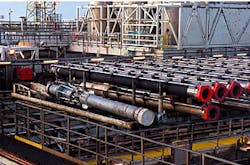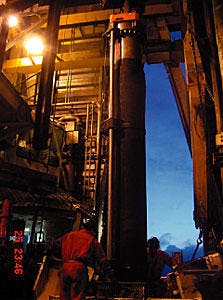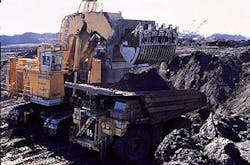Norske Conoco AS and Kvaerner Oil Field Products AS have developed a high-pressure composite drilling riser for field demonstration, which they believe is the world's first.
Partially sponsored by EU Thermie, the companies successfully tested the composite riser during live drilling operations, at the Statoil AS-operated Heidrun tension-leg platform in the Norwegian Sea. During the test, a 15-m joint of the new riser replaced an equivalent high pressure 22-in. titanium joint in the drillstring riser.
The composite riser joints, developed for production and drilling operations in deep waters, are made of carbon fibers and epoxy resin. The weight is less than one-half that of a steel riser and two-thirds that of a titanium riser.
After the first drilling cycle on a Heidrun well, the composite riser was thoroughly inspected and pressure tested by Det Norske Veritas (DNV), say the companies. The new riser joints will remain on the Heidrun TLP for further testing and operation.
Riser development
Kvaerner and Conoco formed a composite alliance in 1995 and have since been involved developing both composite production and drilling risers and composite tethers. Carbon-fiber composite materials can provide the required properties such as high specific strength, high stiffness, low weight, corrosion resistance, high thermal insulation, and excellent fatigue performance.
The composite alliance companies expect the technology will facilitate cost-efficient deepwater field developments and even in some cases contribute toward a step change in economical exploitation of deepwater oil and gas fields.
As exploration and production of oil and gas move into deeper water, weight, cost, and reliability of water-depth-sensitive systems such as risers become increasingly important. Therefore, major efforts have been devoted during the last few years to assess the potential of composite materials for deepwater riser applications.
The term "composite riser" is used to cover the different types of discrete high-pressure pipes with metal connectors that extend from the seabed to the surface. These include components such as drilling risers, production risers, workover risers, catenary risers, production tubing, choke and kill lines, and mud return lines.
Conoco and Kvaerner say that the use of composites permits greater design flexibility for tailoring properties to meet specific design requirements, thus promoting better system-oriented, cost-effective solutions. Also, new innovations are being developed to embed fiber optics and electrical conductors into composite risers for monitoring structural integrity, obtaining operational conditions from remote locations and applying active heating.
Capitalizing on these advantages for composite riser application results in lower system cost and higher reliability for deepwater developments.
Technology status
The Conoco-Kvaerner composite drilling riser program involved designing, manufacturing, and testing four full diameter 22-in. joints under static, fatigue, and impact loading conditions.
The production riser program involved testing four full diameter
10 3/4-in. composite joints that were instrumented with fiber optics.
The companies have concluded from these tests that the current state-of-the-art of the composite manufacturing industry is robust enough to allow reliable design and manufacture of composite risers.
The composite drilling project used titanium liners and connectors before applying the composite over wrap. Fig. 1 shows a completed composite riser joint at the fabrication plant prior to factory acceptance testing.
The companies selected titanium end connectors, compatible with the other titanium drilling riser joints being used, since the goal was to qualify a composite riser joint for field demonstration on Heidrun TLP in the Norwegian North Sea.
Fig. 2 shows a composite-drilling riser joint stacked on the pipe rack on the Heidrun TLP along with other titanium-drilling risers.
In addition, the companies initiated a project to qualify composite riser joints with steel liners and steel connectors. The design of these riser joints is complete and testing of sub-scale joints is underway.
Riser integrity
The in-service assessment of a composite riser's integrity is a concern that stems from the lack of available inspection systems for composite materials. To address the concern, Conoco and Kvaerner, in cooperation with DNV, are currently conducting a project to qualify in-service inspection methods such as fiber optics and acoustic emissions.
Fiber optics were installed in the composite production riser during fabrication by bonding sensors to liner welds and embedding other sensors in the composite laminate.
Fig. 3 shows the trend of resulting strain measurements from four fiber optic sensors during a pressure test of the joint. The qualification of these sensors are expected to alleviate concerns by regulatory agenecies and ensure high in-service reliability of composite risers.
Field demonstration
In spite of the high level of interest in composite risers, along with the large business opportunity, say the companies, commercial application of composite risers remains tentative because of uncertainties associated with new technology.
The difficulty arises from perceived technical barriers in addition to concerns with potential cost escalation and schedule delays. Generally, the first use of a technology removes some of the barriers, making field demonstration key to the Conoco-Kvaerner joint industry project.
The opportunity to demonstrate the composite drilling riser application on the Heidrun TLP was important because it imposed severe loading and operational conditions coupled with strict North Sea regulatory requirements.
High loading severity results from the large 22-in. size drilling riser, the 6,200-psi working pressure and high bending fatigue loads.
Severe operating conditions are inherent in drilling operations where running tools can cause internal damage, repeated handling can cause external damage, and there is risk of impact from dropped objects.
The dropped-object-impact design criteria for Heidrun is 50 kJ (5,000 kg-m) at or below the 50-m water depth and 250 kJ (25,000 kg-m) above the 50-m water depth.
North Sea regulations are strict-more so than other offshore areas. Accordingly, DNV certified the riser design, test analyses, qualification tests, manufacturing procedures, and final acceptance testing.
Another important requirement for the composite riser field demonstration is that operators must not experience additional requirements to run the system. Fig. 4 shows the composite riser joint being run through the rig floor.
Installed in the Heidrun TLP well A-41 in July 2001, the composite riser joint successfully met all of these requirements during the 1-month operation. The composite joint was successfully pressure tested before and after the run. The companies also report that it was also thoroughly inspected before installing it again at another well, for the second phase of the test.
Engineers first installed the composite joint at the bottom of the riser string, above the taper joint, where it was subjected to the highest bending loads. Subsequently it was installed in the middle of the string and future plans call for the composite joint to be moved to other locations along the riser.
In-service inspection
Developing an in-service inspection strategy is an important element of the field demonstration program. Engineers developed the plan to include nondestructive testing (NDT) inspection of the titanium liner welds and measurements of both axial displacements and volumetric expansion or contraction under the field pressure test conditions.
To establish base line data for the axial displacements and the volumetric expansion, engineers measured their values during the factory acceptance test that involved two pressure cycles at 6,200 psi and one pressure cycle at the field pressure test of 4,600 psi.
Technicians established the volumetric contraction by measuring the amount of water discharged from the joint as it is depressurized from 4,600 psi. Tests performed on the joint in service corresponded very well with the factory acceptance tests performed at the manufacturing site, say the companies.
The composite drilling riser joint that was designed, qualified, and installed on Heidrun demonstrated the maturity of the composites industry to satisfy rigorous offshore requirements. The Heidrun joint may not be economical for other projects due to the use of titanium liner and connectors, which was a specific requirement for Heidrun.
The project to manufacture and qualify composite riser joints with steel liners and connectors, are directed at meeting market demand for low cost composite risers.
Economics
The offshore industry will adopt new technology only if it improves profitability, enhances safety, or provides some enabling capability, say Conoco and Kvaerner.
Lowering capital investment and reducing operating and maintenance costs improves profitability. Since the cost of composite riser joints is about 30% higher than equivalent steel riser joints, improving project profitability is only realized by improving life cycle costs.
Composite risers can impact the life cycle economics by improving payload capacity, increasing water depth capability, improving overall system safety and reliability, and reducing maintenance cost. They can even be an enabling technology for deepwater TLP and Spar concepts.
As example, composite-drilling risers require less buoyancy than steel counterparts and allow for more riser joints to be stored on the deck and the riser joints can fit through a smaller rotary table. Also, the lighter composite riser joints mean less required tension and a smaller deck load, allowing a rig to carry extra casing.
Generally economic studies focus on savings from weight and riser tension reductions that composite risers offer. The companies also say other attractive properties of composites can lead to significant savings:
- Engineers can design composite production tubing with zero coefficient of thermal expansion, eliminating the need for leak prone slip joints.
- Composite production tubing and risers have much higher thermal insulation capacity than steel components, beneficial to flow assurance issues (Table 1). High thermal insulation is necessary to prevent plugging due to paraffin, asphaltene, and hydrate deposition. Many deepwater steel risers require thermal insulation or active heating.
- Composite riser materials can incorporate electrical conductors within the structural laminate, to provide conductors for active heating or other instrumentation.
- Composite drilling risers can have high structural damping effects that manufacturers can enhance by the tailoring the laminate. Exploiting this property may eliminate the need for the strakes required to suppress vortex-induced vibrations.







